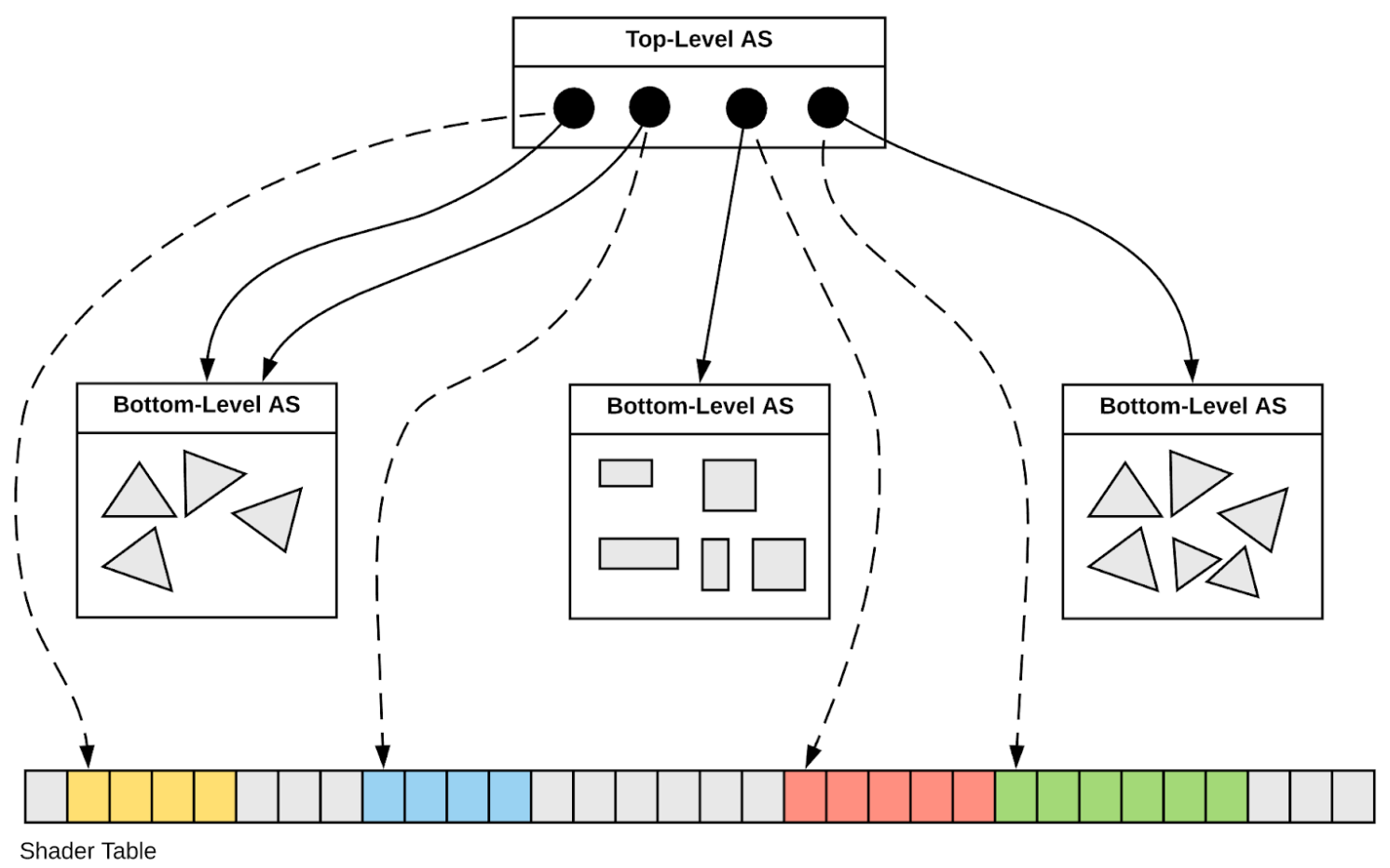LZ-Opticks-NVIDIA OptiX 6->7 : Notes
- https://github.com/simoncblyth/CSG/commits https://github.com/simoncblyth/CSGOptiX/commits
- https://github.com/simoncblyth/CSGOptiXGGeo/commits
PROGRESS : OptiXTest split in two, added Opticks/GGeo conversion
- CSG : CSGFoundry model, simple intersect headers : CPU testable
- CSGOptiX : OptiX 7 + pre-7 renders of CSGFoundry geometry
- CSGOptiXGGeo : loads Opticks/GGeo, converts to CSG and renders using CSGOptiX
NEXT STEPS:
- debug GGeo -> CSGFoundry conversion : relative transforms, instances
- Add CSG + CSGOptiX packages to Opticks
- performance test full geometry approaches (split/join GAS, 1 or more IAS)
- optixrap/cu/generate.cu : photon generation + propagation : expts
- pull out simple headers common to: pre-7, 7, CPU testing
- minimize code difference between : pre-7, 7, CPU-testing
- trickery/mocking needed for CURAND on CPU? (templating?)
LONGTERM POSSIBILITY : Populate CSGFoundry model direct from Geant4 geometry ? [Disruptive]
CSG : CSGFoundry/CSGSolid/CSGPrim/CSGNode/csg_intersect_tree/..
CSGFoundry : Instances + Solids
struct CSGFoundry
{
...
void upload();
...
std::vector<CSGSolid> solid ;
std::vector<CSGPrim> prim ;
std::vector<CSGNode> node ;
std::vector<float4> plan ;
std::vector<qat4> tran ;
std::vector<qat4> itra ;
std::vector<qat4> inst ;// instance transforms
CSGPrim* d_prim ;
CSGNode* d_node ;
float4* d_plan ;
qat4* d_itra ; // inverse CSG transforms
};
- https://github.com/simoncblyth/CSG
- CSG : soon to become an Opticks package
All solids+constituents created via Foundry (ref by index)
- CSGSolid : 1 or more CSGPrim : ( CSGSolid -> GAS )
- CSGPrim : 1 or more CSGNode : (CSGPrim ~ G4VSolid)
- (nodeOffset, numNode) -> SBT HitGroup record
- CSGNode : CSG constituents
- basis shapes : sphere, box3, cone, cylinder, ...
- boolean operators : union, intersection, difference
- qat4 : scale-rotate-translate transform
- float4 : planes (normal + distance to origin)
- csg_intersect_tree.h/csg_intersect_node.h/...
- simple headers common to pre-7/7/CPU-testing
- CSGScan : CPU intersect testing
- CSGFoundry::upload
- all solids in geometry -> only four GPU allocations : d_prim, d_node, d_plan, d_itra
https://github.com/simoncblyth/CSG/blob/main/CSGFoundry.h https://github.com/simoncblyth/CSG/blob/main/qat4.h
OptiX 7 + pre-7 intersecting same CSGFoundry geometry
geo_OptiX6Test.cu
- Duplicate 7 environment in pre-7
24 rtBufferprim_buffer; // geometry level context 25 28 rtBuffernode_buffer; // global context 29 rtBuffer .. 40 RT_PROGRAM void intersect(int primIdx) 41 { 42 const CSGPrim* prim = &prim_buffer[primIdx] ; 43 int nodeOffset = prim->nodeOffset() ; 44 int numNode = prim->numNode() ; 45 const CSGNode* node = &node_buffer[nodeOffset] ; 46 const float4* plan = &plan_buffer[0] ; 47 const qat4* itra = &itra_buffer[0] ; 48 49 float4 isect ; 50 if(intersect_prim(isect, numNode, node, plan, itra, ray.tmin , ray.origin, ray.direction )) 51 { 52 if(rtPotentialIntersection(isect.w)) 53 { 55 shading_normal = make_float3( isect ); 57 rtReportIntersection(0); 58 } 59 } 60 }itra_buffer; 30 rtBuffer plan_buffer;
- https://github.com/simoncblyth/CSGOptiX
OptiX7Test.cu
150 extern "C" __global__ void __intersection__is()
151 {
152 HitGroupData* hg = (HitGroupData*)optixGetSbtDataPointer();
153 int numNode = hg->numNode ;
154 int nodeOffset = hg->nodeOffset ;
155
156 const CSGNode* node = params.node + nodeOffset ;
157 const float4* plan = params.plan ;
158 const qat4* itra = params.itra ;
159
160 const float t_min = optixGetRayTmin() ;
161 const float3 ray_origin = optixGetObjectRayOrigin();
162 const float3 ray_direction = optixGetObjectRayDirection();
163
164 float4 isect ;
165 if(intersect_prim(isect, numNode, node, plan, itra,
t_min , ray_origin, ray_direction ))
166 {
...
175 optixReportIntersection( isect.w, hitKind, a0, a1, a2, a3 );
176 }
177 }
Minimize code split : 7, pre-7, CPU testing : same intersect_prim
CSGOptiXGGeo : loads Opticks/GGeo, converts to CSG and renders
Converter : GGeo/GParts -> CSG
11 struct Converter
12 {
13 CSGFoundry* foundry ;
14 const GGeo* ggeo ;
16 float splay ;
17
18 Converter(CSGFoundry* foundry, const GGeo* ggeo ) ;
19
20 void convert(int repeatIdx,
int primIdx,
int partIdxRel );
21 void convert_();
22
23 CSGSolid* convert_(unsigned repeatIdx );
24 void addInstances(unsigned repeatIdx );
25
26 CSGPrim* convert_(const GParts* comp,
unsigned primIdx );
27 CSGNode* convert_(const GParts* comp,
unsigned primIdx,
unsigned partIdxRel );
28 };
- https://github.com/simoncblyth/CSGOptiXGGeo
06 #include "CSGFoundry.h"
07 #include "CSGOptiX.h"
09 #include "Converter.h"
10
11 int main(int argc, char** argv)
12 {
13 int repeatIdx = argc > 1 ? atoi(argv[1]) : 0 ;
..
19 OPTICKS_LOG(argc, argv);
20 Opticks ok(argc, argv);
21 ok.configure();
22
24 GGeo* ggeo = GGeo::Load(&ok);
26
27 CSGFoundry foundry ;
28 Converter conv(&foundry, ggeo, dump) ;
29 conv.convert(repeatIdx, primIdx, partIdxRel);
30
31 CSGOptiX cx(&foundry);
34 foundry.upload(); // uploads nodes, planes, transforms
..
52 cx.setCE(ce, tmin, tmax);
53 cx.render( tspec );
55 return 0 ;
56 }
- GGeo::Load geocache identified by OPTICKS_KEY envvar
- Perhaps: go direct Geant4 -> CSG ?
- disruptive but significant simplification of NPY/NNode
CSGOptiXGGeo_0
- JUNO GGeo -> CSGFoundry
- CSGOptiX renders :
- OptiX 5 (LHS)
- OptiX 7 (RHS)
- Unexplained difference
- remainder solid (~3000 volumes combined)
CSGOptiXGGeo_1
- JUNO GGeo -> CSGFoundry
- CSGOptiX renders :
- OptiX 5 (LHS, white background)
- OptiX 7 (RHS, grey background)
CSGOptiXGGeo_2
Converter debugging
- misses relative transforms perhaps ?
- instances not working yet
CSGOptiXGGeo_3
CSGOptiXGGeo_4
CSGOptiXGGeo_5
CSGOptiXGGeo_6
CSGOptiXGGeo_7
- cutout from tmin sphere
CSGOptiXGGeo_8
One JUNO solid (fastener) -> blank
- renders very slowly with old machinery
CSGOptiXGGeo_9
Proof that relative trans not applied
- should be many "planks" here
"Extra" Background Slides Follow
Two-Level Hierarchy : Instance transforms (TLAS) over Geometry (BLAS)
OptiX supports multiple instance levels : IAS->IAS->GAS BUT: Simple two-level is faster : works in hardware RT Cores
- AS
- Acceleration Structure
- TLAS (IAS)
- 4x4 transforms, refs to BLAS
- BLAS (GAS)
- triangles : vertices, indicescustom primitives : AABB
- AABB
- axis-aligned bounding box
SBT : Shader Binding Table
Flexibly binds together:
- geometry objects
- shader programs
- data for shader programs
Hidden in OptiX 1-6 APIs
Optimizing Geometry : Split BLAS to avoid overlapping bbox
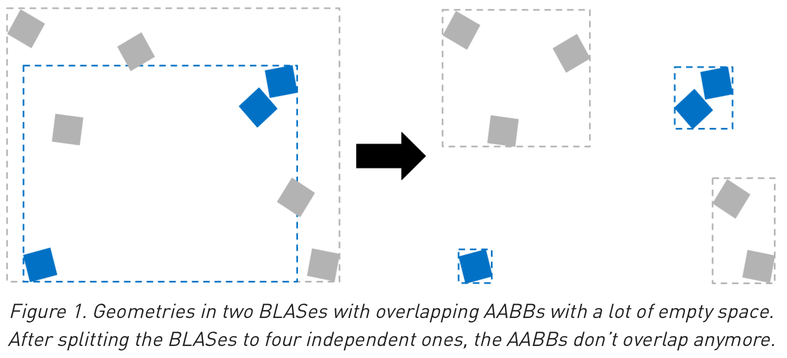
Optimization : deciding where to draw lines between:
- structure and solid (IAS and GAS)
- solids within GAS (bbox choice to minimize traversal intersection tests)
Where those lines are drawn defines the AS
https://developer.nvidia.com/blog/best-practices-using-nvidia-rtx-ray-tracing/
Optimizing Geometry : Merge BLAS when lots of overlaps
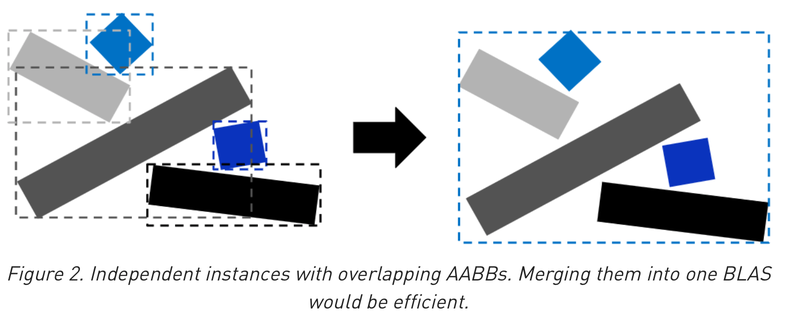
- lots of overlapping forces lots of intersections to find closest
- but too few bbox means the AS cannot help to avoid intersect tests
- balance required : needs experimentation and measurement to optimize
https://developer.nvidia.com/blog/best-practices-using-nvidia-rtx-ray-tracing/
Ray Intersection with Transformed Object -> Geometry Instancing
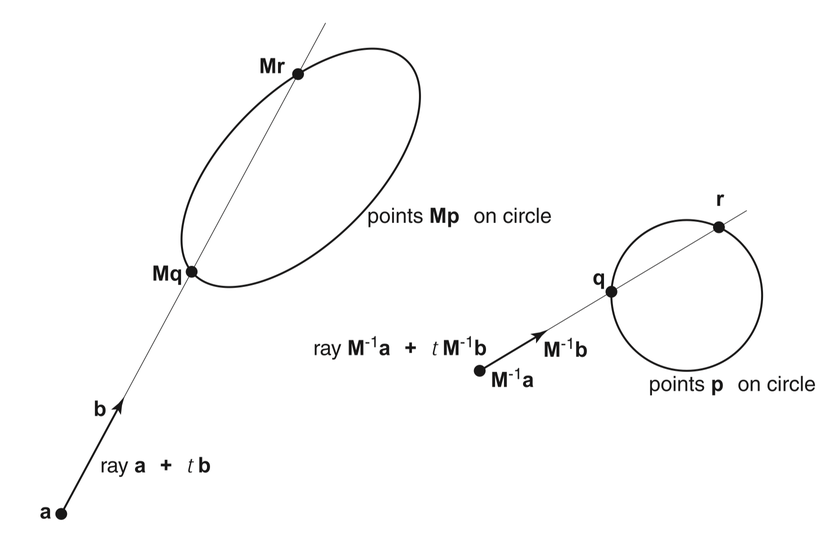
Fig 13.5 "Realistic Ray Tracing", Peter Shirley
Advantages apply equally to acceleration structures
Equivalent Intersects -> same t
- ray with ellipsoid : M*p
- M-1 ray with sphere : p
Local Frame Advantages
- simpler intersect (sphere vs ellipsoid)
- closer to origin -> better precision
Geometry Instancing Advantages
- many objects share local geometry
- orient+position with 4x4 M
- huge VRAM saving, less to copy
Requirements
- must not normalize ray direction
- normals transform differently
- N' = N * M-1T
- (due to non-uniform scaling)
G4Boolean -> CUDA/OptiX Intersection Program Implementing CSG
Outside/Inside Unions
dot(normal,rayDir) -> Enter/Exit
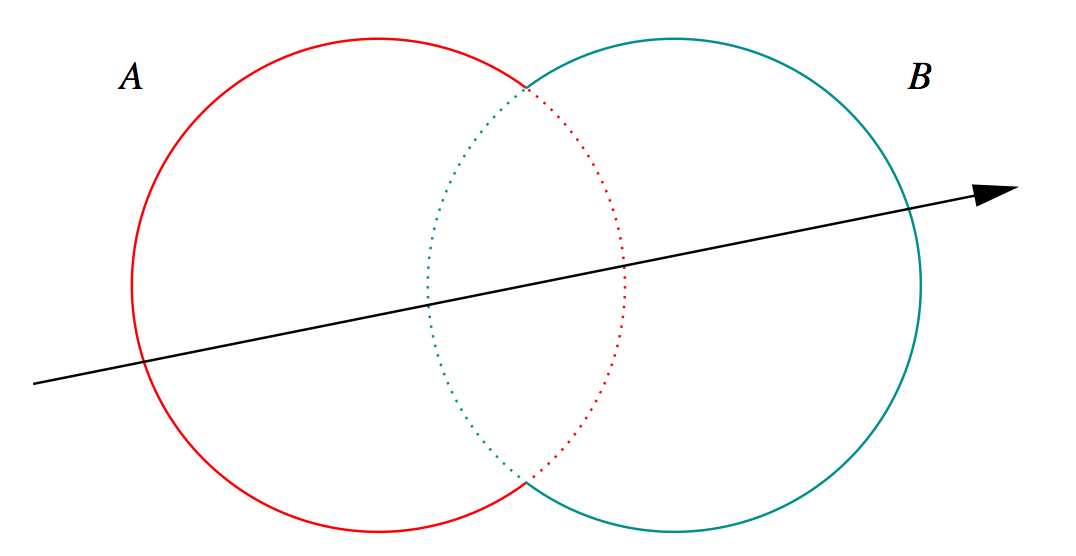
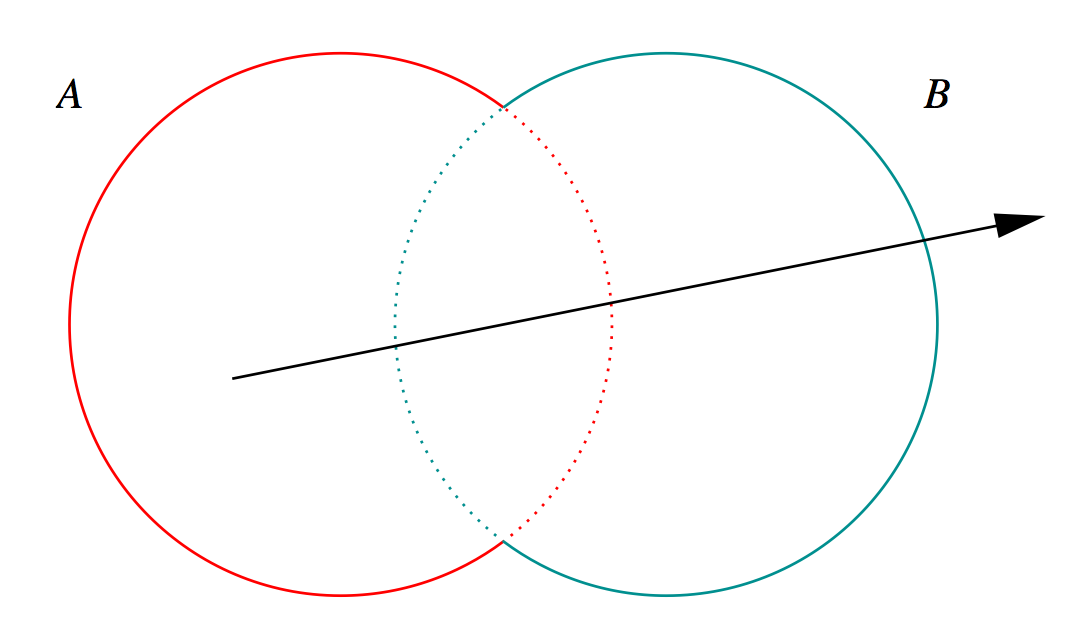
- A + B boundary not inside other
- A * B boundary inside other
Complete Binary Tree, pick between pairs of nearest intersects:
| UNION tA < tB | Enter B | Exit B | Miss B |
|---|---|---|---|
| Enter A | ReturnA | LoopA | ReturnA |
| Exit A | ReturnA | ReturnB | ReturnA |
| Miss A | ReturnB | ReturnB | ReturnMiss |
- Nearest hit intersect algorithm [1] avoids state
- sometimes Loop : advance t_min , re-intersect both
- classification shows if inside/outside
- Evaluative [2] implementation emulates recursion:
- recursion not allowed in OptiX intersect programs
- bit twiddle traversal of complete binary tree
- stacks of postorder slices and intersects
- Identical geometry to Geant4
- solving the same polynomials
- near perfect intersection match
- [1] Ray Tracing CSG Objects Using Single Hit Intersections, Andrew Kensler (2006)
- with corrections by author of XRT Raytracer http://xrt.wikidot.com/doc:csg
- [2] https://bitbucket.org/simoncblyth/opticks/src/tip/optixrap/cu/csg_intersect_boolean.h
- Similar to binary expression tree evaluation using postorder traverse.
Constructive Solid Geometry (CSG) : Shapes defined "by construction"
CSG Binary Tree
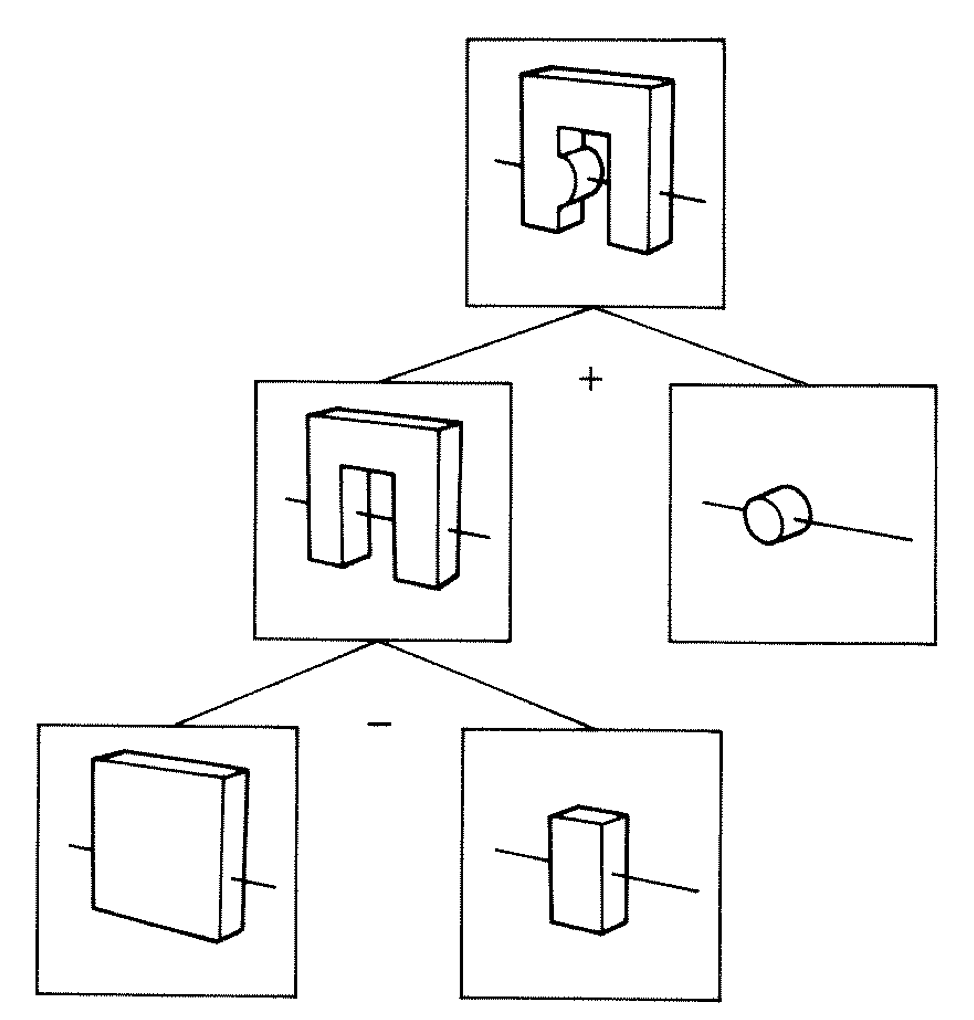
Primitives combined via binary operators
Simple by construction definition, implicit geometry.
- A, B implicit primitive solids
- A + B : union (OR)
- A * B : intersection (AND)
- A - B : difference (AND NOT)
- !B : complement (NOT) (inside <-> outside)
CSG expressions
- non-unique: A - B == A * !B
- represented by binary tree, primitives at leaves
3D Parametric Ray : ray(t) = r0 + t rDir
Ray Geometry Intersection
- primitive : find t roots of implicit eqn
- composite : pick primitive intersect, depending on CSG tree
How to pick exactly ?
CSG : Which primitive intersect to pick ?
In/On/Out transitions
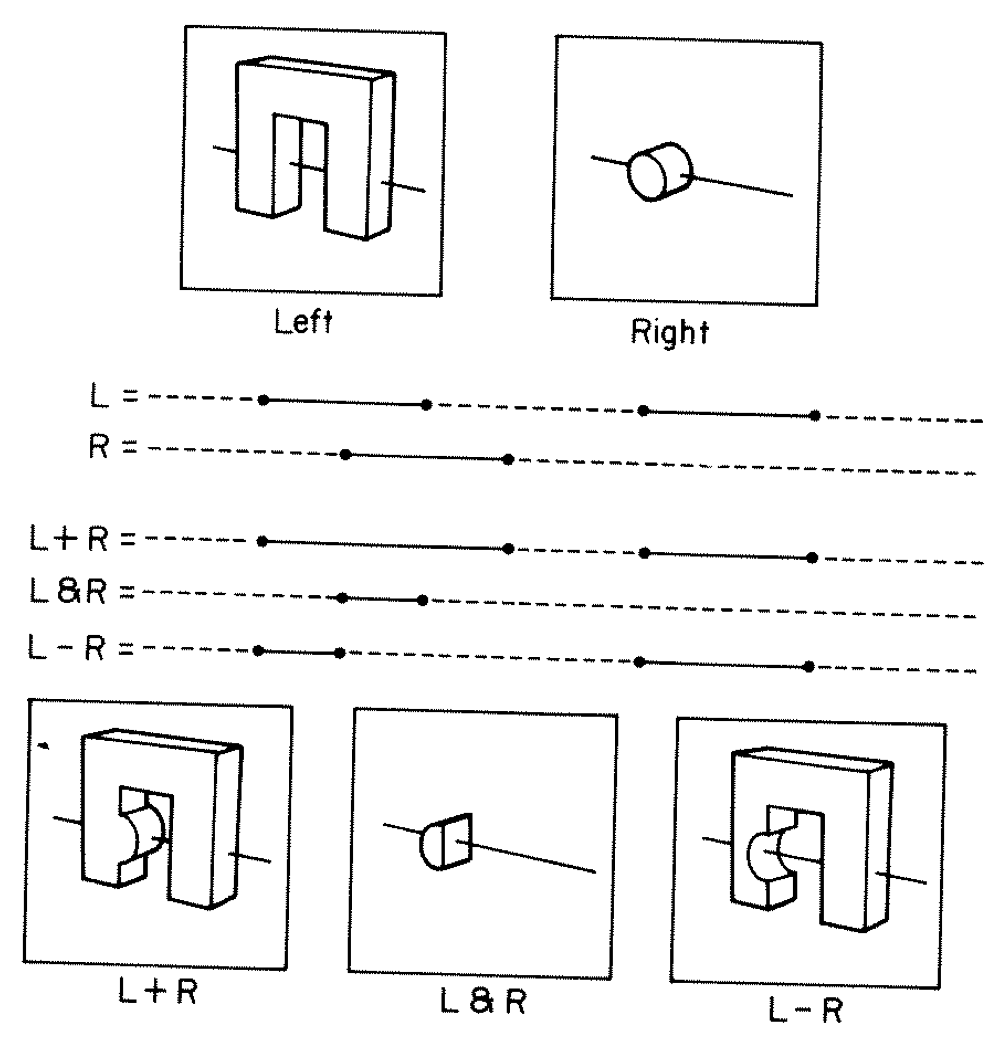
Classical Roth diagram approach
- find all ray/primitive intersects
- recursively combine inside intervals using CSG operator
- works from leaves upwards
Computational requirements:
- find all intersects, store them, order them
- recursive traverse
BUT : High performance on GPU requires:
- massive parallelism -> more the merrier
- low register usage -> keep it simple
- small stack size -> avoid recursion
Classical approach not appropriate on GPU
CSG Complete Binary Tree Serialization -> simplifies GPU side
Bit Twiddling Navigation
- parent(i) = i/2 = i >> 1
- leftchild(i) = 2*i = i << 1
- rightchild(i) = 2*i + 1 = (i << 1) + 1
- leftmost(height) = 1 << height
Geant4 solid -> CSG binary tree (leaf primitives, non-leaf operators, 4x4 transforms on any node)
Serialize to complete binary tree buffer:
- no need to deserialize, no child/parent pointers
- bit twiddling navigation avoids recursion
- simple approach profits from small size of binary trees
- BUT: very inefficient when unbalanced
Height 3 complete binary tree with level order indices:
depth elevation
1 0 3
10 11 1 2
100 101 110 111 2 1
1000 1001 1010 1011 1100 1101 1110 1111 3 0
postorder_next(i,elevation) = i & 1 ? i >> 1 : (i << elevation) + (1 << elevation) ; // from pattern of bits
Postorder tree traverse visits all nodes, starting from leftmost, such that children are visited prior to their parents.
Evaluative CSG intersection Pseudocode : recursion emulated
fullTree = PACK( 1 << height, 1 >> 1 ) // leftmost, parent_of_root(=0) tranche.push(fullTree, ray.tmin) while (!tranche.empty) // stack of begin/end indices { begin, end, tmin <- tranche.pop ; node <- begin ; while( node != end ) // over tranche of postorder traversal { elevation = height - TREE_DEPTH(node) ; if(is_primitive(node)){ isect <- intersect_primitive(node, tmin) ; csg.push(isect) } else{ i_left, i_right = csg.pop, csg.pop // csg stack of intersect normals, t l_state = CLASSIFY(i_left, ray.direction, tmin) r_state = CLASSIFY(i_right, ray.direction, tmin) action = LUT(operator(node), leftIsCloser)(l_state, r_state) if( action is ReturnLeft/Right) csg.push(i_left or i_right) else if( action is LoopLeft/Right) { left = 2*node ; right = 2*node + 1 ; endTranche = PACK( node, end ); leftTranche = PACK( left << (elevation-1), right << (elevation-1) ) rightTranche = PACK( right << (elevation-1), node ) loopTranche = action ? leftTranche : rightTranche tranche.push(endTranche, tmin) tranche.push(loopTranche, tminAdvanced ) // subtree re-traversal with changed tmin break ; // to next tranche } } node <- postorder_next(node, elevation) // bit twiddling postorder } } isect = csg.pop(); // winning intersect
https://bitbucket.org/simoncblyth/opticks/src/tip/optixrap/cu/csg_intersect_boolean.h
CSG Deep Tree : Positivize tree using De Morgan's laws
Positive form CSG Trees
Apply deMorgan pushing negations down tree
- A - B -> A * !B
- !(A*B) -> !A + !B
- !(A+B) -> !A * !B
- !(A - B) -> !(A*!B) -> !A + B
End with only UNION, INTERSECT operators, and some complemented leaves.
COMMUTATIVE -> easily rearranged
1st step to allow balancing : Positivize : remove CSG difference di operators
... ...
un cy
un cy
un cy
un cy
un cy
di cy
cy cy
... ...
un cy
un cy
un cy
un cy
un cy
in cy
cy !cy
